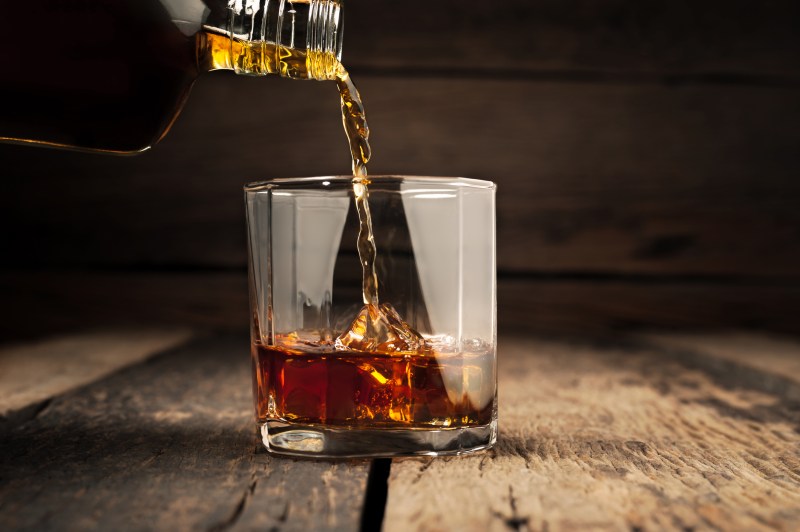If you’re new to the whisk(e)y world, you might feel a little overwhelmed by all the different types of whiskey (only the U.S. and Ireland use the “e”). There’s bourbon, rye whiskey, Irish whiskey, single malt Scotch, blended Scotch, Canadian whisky, Japanese whisky, and so much more.
Before anything, how are any of these whiskeys different (besides the clear geographical markers)? And while we could get into dissecting the intricate differences between each one of the above-listed whiskey styles, today, we are sticking to two very different types. We’re talking about bourbon and Scotch — a whiskey and whisky.
What is bourbon?

While rye whiskey might have been around longer, bourbon is referred to as America’s “native spirit.” There’s no whiskey more entrenched in the history of the U.S. than bourbon. You can’t call just any American-made whiskey a bourbon, though.
There are certain rules. To be called a bourbon, it must first be made with a mash bill of at least 51% corn (although most are much higher). The other grains can be barley, wheat, rye, or other ingredients. It also must be made in the U.S. (not just Kentucky, as some would have you believe). This includes Washington, D.C., and even Puerto Rico.
It can’t be distilled to a proof higher than 160. It must be matured in new, charred oak barrels. While there’s no minimum, it must spend two years in the barrel to be called a straight bourbon. When bottled, it can’t be less than 80 proof. Distillers and blenders also can’t add any coloring or flavorings. Water is OK when proofing it down, though.
What is Scotch?

There’s a reason it’s called “Scotch” whisky. To be referred to as a Scotch whisky, the first step involves location. It might seem self-explanatory, but Scotch whisky must be distilled in (you guessed it) Scotland. It can only be made with grains, water, and yeast (single malt Scotch is made solely with malted barley).
Once distilled, the strength cannot exceed 94.8% ABV. Higher, and you might be dealing with a neutral grain spirit and lose all the aromas and flavors drinkers enjoy. It must be aged in Scotland in oak barrels for a minimum of three full years. When bottled, it can’t be less than 80 proof. If the whisky has an age statement on the bottle, it must reference the youngest whisky included (this pertains to blended whiskies in particular).
How are they the same?

The two spirits have a lot in common. Both cannot be bottled at less than 80 proof. Both are aged in oak barrels. Both spirits are made with grains. Bourbon mostly with corn, but also with barley and other ingredients while Scotch is often made with malted barley. Both whisk(e)ys can be enjoyed neat, on the rocks, or mixed into a classic cocktail.
How are they different?

First, bourbon is made in the U.S., and Scotch is made in Scotland. That’s a pretty big difference. Second, bourbon has only been distilled since the 1700s, while the first record of Scotch whisky dates to the late 1400s.
Another difference is the fact that bourbon is a corn-based spirit while Scotch is mostly a malted barley-based spirit. As we briefly touched on, there’s no minimum aging requirement (except for two years if you want to make a straight whiskey) for bourbon, while Scotch must be matured for at least three years. As you can see, while they are both whiskeys, there are obvious differences.
How do their flavor palates vary?

The differences aren’t just in location and ingredients; they are also in overall flavor. While there are peat-smoked, briny whiskies from Islay and coastal distilleries, Scotch whiskies generally carry a variety of noticeable flavors. These include vanilla beans, honey, heather, candied orange peels, and oaky wood. They’re also drier than bourbon.
Bourbon, on the other hand, begins with a burst of sweet corn flavor. Other flavors include pipe tobacco, dried fruits, vanilla, caramel, chocolate, and charred oak. Drink them side by side, and there’s no disputing the differences.
Bottom line

While many Scotch drinkers also enjoy bourbon and vice versa, the two whiskeys are different enough that it’s understandable why some drinkers stick to one or the other. If you’re one of the latter groups (specifically folks who stick to bourbon only), we suggest trying a single malt Scotch matured in an ex-bourbon barrel to get acquainted with the Scottish whisky style.
We’re all about trying new things. Don’t limit yourself to one form of whiskey. Try new bourbons. Try new Scotch whiskies. Try new rye whiskeys. Just try new whiskeys. It’s the only way you’ll build your palate so you can really enjoy all the nuanced, complex aromas and flavors found in your favorite expressions.




